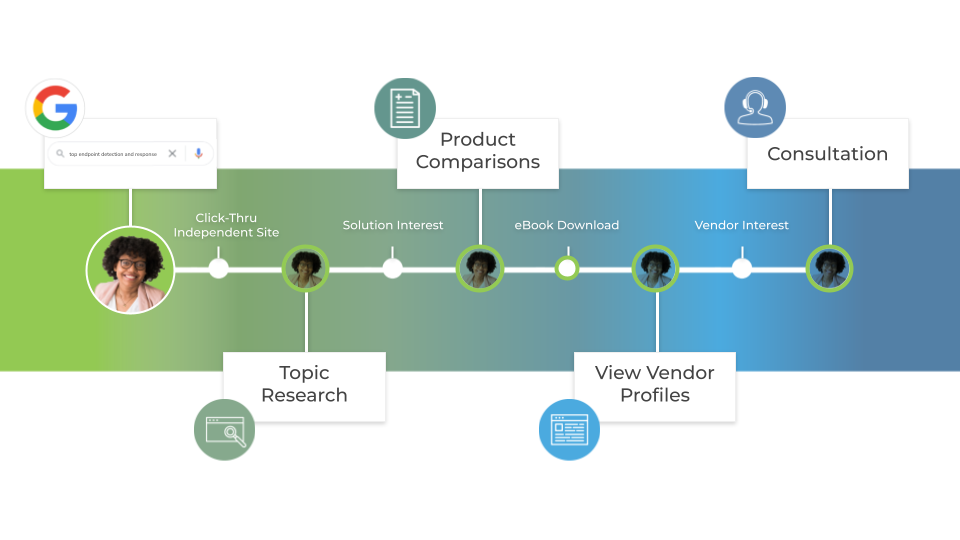The right message, to the right buyer, in the right place, at the right time.
Just-in-time marketing is a simple yet powerful concept that B2B marketers strive to make a reality across their brand and demand programs. It’s a clear path to influencing buying decisions, capturing demand, and maximizing the efficiency of marketing and sales programs.
While the idea itself is simple, putting it into practice rarely is. And in a world of increasingly self-service buying journeys where the desire for trustworthy, independent data is at an all-time high, it’s only getting more challenging.
But the emergence of 2nd party data coupled with new technology partnerships is helping to make just-in-time marketing a reality for more businesses to help them engage the right leads at the right time – even if those leads have never set foot on their website.
Where, Oh Where, Are My Buyers?
The rise of the digital native B2B buyer has had one of the most significant impacts on the world of marketing in recent memory.
Gone are the days of businesses reaching out to vendors throughout their technology research process. According to various analyst firms including Forrester Research and Gartner, the average B2B buyer now completes more than 80% of their buying process in a self-service manner using trusted online resources before ever engaging a vendor’s sales team. And that number will continue to grow as tech review sites flourish, more niche YouTube channels emerge, B2B influencers rise in popularity, and AI-powered research tools make it easier than ever for buyers to discover, compare, and even evaluate solutions on their own terms.
Meanwhile, as buyers take more control over their research process, the journeys they’re taking have become increasingly complex and unique thanks to the proliferation of new media types and diverging personal preferences. While one buyer may prefer to read articles and comparisons on trusted media sites, another may choose to watch YouTube videos, listen to podcasts, subscribe to an industry newsletter, and consult directly with an expert.
This new world of buyer-led research and evaluation makes it more difficult for vendors to identify who is in-market for a solution like theirs, and to influence that purchase decision. After all, if they aren’t learning on your website or speaking with your sales team, they may be invisible to your marketing team making it impossible to deliver the right message at the right time.
Unless you’re able to access lead data and real-time buying signals directly from the 3rd party websites, newsletters, and other digital channels that buyers are now relying on. These precious buying signals are also known as 2nd party data.
Understanding 1st, 2nd, and 3rd Party Lead Data
Most marketers are already using 1st party and 3rd party lead data. In a nutshell, 1st party lead data is information you track and store about a lead based on their direct interactions with websites and online resources that you own and operate. This data typically comes from activities and form fills on your corporate website, email marketing engagement, participation in events that you host, etc.
On the other hand, 3rd party lead data is information you source from an external data provider, who is in turn sourcing, scraping, or aggregating that data from other online data sources or by using cookies or embedded scripts to track activities on other independent web properties. Contact data acquired from a list provider is a common example of 3rd party data, as is the majority of buyer intent information acquired via intent data providers. This data can provide valuable insights on leads who are not yet engaging on your owned properties, however, the data may not always be accurate, reliable, or timely.
2nd party lead data, a newer concept for many marketers, is information you source from a trusted partner which they have tracked and analyzed from direct interactions on their own websites, newsletters, social media channels, webinars, phone calls, etc. In other words, 2nd party data is a trusted partner’s own 1st party data!
For example, a company like TechnologyAdvice owns and operates a wide range of tech media sites, newsletters, social media feeds, and other channels that business professionals use to discover, compare, and evaluate products and services. TechnologyAdvice tracks and gathers their own 1st party data for this large online audience that they own, and in turn shares that data with other marketing teams to help them discover buying signals from leads and accounts who are actively researching solutions across their properties. Because this data is TechnologyAdvice’s own proprietary 1st party data, it offers a greater degree of accuracy, reliability, and perhaps most importantly, timeliness over traditional 3rd party data.
Using 2nd Party Data to Fuel Just-in-Time Marketing
2nd party data unlocks new opportunities for marketers to leverage timely buying signals throughout the entire buying journey of a potential prospect, not just the final 20% (assuming your solution even made the shortlist). AMAZING! But what does that have to do with the idea of just-in-time marketing?
A whole heck of a lot.
Because now, when your potential buyers go off on their own unique buying journeys, you can identify them as in-market leads and discover what content, articles, reviews, and comparisons each of them are interacting with as they progress through their research in their own unique ways.
Armed with that 2nd party data, you can now engage those buyers with the right message at the right time – whether or not they have ever visited your company’s website. And not only that, but if the 2nd party data provider also offers the ability to target those leads with marketing assets and communications via those same channels that they own and operate (which companies like TechnologyAdvice do!), you can engage them in the right place as well – all just-in-time.
Scaling Just-in-Time Marketing with TechnologyAdvice and ZoomInfo
And just when you thought it couldn’t get any better, solution providers like TechnologyAdvice and ZoomInfo are now partnering to empower businesses to trigger just-in-time marketing and sales actions in an automated way based on 2nd party data buying signals.
With TechnologyAdvice’s new integration, ZoomInfo customers will be able to create custom go-to-market (GTM) ‘Plays’ that automate marketing and sales workflows based on actions tech buyers are taking across TechnologyAdvice’s ecosystem of websites and digital channels.
For example, let’s say that you run marketing at an Accounting Software solution provider. You know that if someone from your target account list is actively reviewing content related to the topic of “Best Accounting Software,” you want to get in front of them immediately with a targeted brand or demand campaign. Using TechnologyAdvice’s 2nd party data integration with ZoomInfo’s workflow automation and 3rd party data platform, you could create a GTM Play like the following:
Taking it one step further, you could also trigger a campaign with TechnologyAdvice to run display ads on the same website where those Best Accounting Software articles and reviews were being engaged with, or to run a targeted ABM campaign across a variety of channels where individuals from that account are active.
The right message, to the right buyer, in the right place, at the right time. Even before they have ever engaged with your own website or content. That is the future of hyper efficient, highly targeted B2B marketing.
CEOs of TechnologyAdvice and ZoomInfo Discuss J.I.T. Marketing
This article was inspired by a live presentation delivered by Rob Bellenfant, Founder and CEO of TechnologyAdvice, and Henry Schuck, Founder and CEO of ZoomInfo, at the B2B Marketing Exchange conference. Watch the live session below to dive deeper into 2nd party data and the rise of just-in-time marketing:
Interested in trying out TechnologyAdvice’s new integration with ZoomInfo so you can run automated GTM Plays like the one above?
Sign up for the upcoming Beta launch by contacting us here with a message saying “Please add me to the TA + ZoomInfo beta!”





